
Avionics shops have been busy. So busy that the wait to get into some of them is almost a year. There are reasons for that. Installation complexity, airframe teardown and equipment shortages mean a longer stay on the shop floor. Plus, shops are still recovering from the ADS-B rush.
To get a feel for how shops and avionics manufacturers rate in the watering eyes of buyers who wrote big checks for the latest gee whiz gear, we surveyed the market. Here’s what we found.
POLLING, DEMOGRAPHICS
We reeled in just shy of 300 responses to a survey posted on sister publication AVweb and our own social media channels. Aside from the questionnaire, we talked with pilots during our travels and at our local airfields, plus we talked with a handful of avionics shops around the country for their view of the market and buying habits of their customers. For this survey we were focused on major upgrades made within the past three years.
The same caveat that applies to other surveys also applies here. The sampling can be skewed because it might attract disgruntled buyers who jump at the chance to clobber a shop or an avionics manufacturer for whatever reason. But it’s also an opportunity for ecstatic customers to rave about their experience. We want to hear it all in hopes of providing useful guidance for others who are ready to drop serious dough on a modern avionics upgrade. There are plenty of lessons to learn. Plus, we were especially interested in buyer demographics.
In the latest survey completed in the fall of 2020, 44 percent of the respondents were in the over-65 age group, 28 percent were 56 to 64, 18 percent were aged 41 to 55 and 10 percent were in the 21 to 40 year-old group.
As for aircraft, 73 percent were single-engine pistons, 12 percent were twins, 10 percent were amateur-built experimentals and 5 percent were turbines. Sixty-one percent of these aircraft are used for recreational flying, 34 percent for business and personal flying and the remaining are for-hire or corporate use. As for hours flown, 45 percent said they fly between 50 and 100 hours per year, 32 percent log between 100 and 200 hours per year, 7 percent fly between 200 and 500 hours per year and 16 percent fly less than 50 hours.
In the survey, 50 percent of the respondents flew a mix of VFR and IFR, 33 percent fly mostly VFR and 17 percent always fly IFR regardless of the weather.
And since you don’t really get a feel for the user interface, overall quality and factory support until you actually put some hours on the new gear, we asked how many hours were flown with the new avionics. Most (35 percent) had flown the equipment between 50 and 100 hours and 32 percent logged less than 50 hours.
The typical warranty period for new gear is two years; most shops will warranty their workmanship (wiring, mainly) for the lifetime of the aircraft with limitations. Understandably, if you bring the aircraft to another shop and they tear into the wiring for whatever reason, the warranty will likely be voided. For that reason, we suggest finding a shop that you like and sticking with it. If you have warranty issues that need to be addressed, work with the installing shop whenever possible. The same goes with dealerships. As an example, we heard from some who took the aircraft to a non-Garmin dealer to resolve a problem and couldn’t get factory support because Garmin will only work with its dealer network. That’s understandable because dealers have access to the latest installation manuals, service bulletins, software and a direct line to technical support.
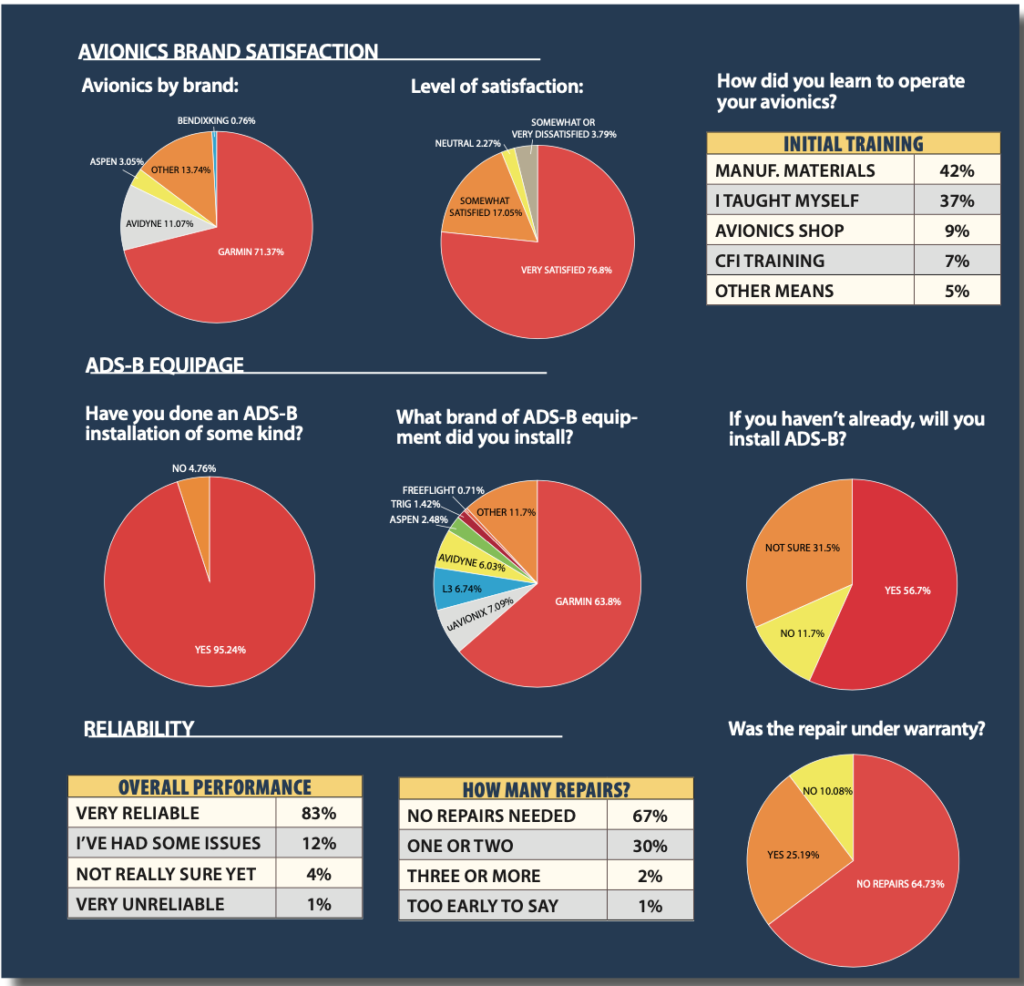
BRANDS THAT SELL
Not surprisingly, Garmin was the hands-down leader in our survey—at 71 percent—when we asked what brand of avionics was recently purchased. Other brands (mainly Dynon, Grand Rapids and Trig Avionics) were 13 percent, Avidyne came in at 11 percent and BendixKing was at the bottom at 0.76 percent.
The meat and potatoes of the survey was satisfaction, of course, and we were pleased to see that 77 percent were very satisfied with the avionics, 17 percent were somewhat satisfied and only 4 percent were somewhat or very dissatisfied.
Of course, the avionics shop that holds your airplane hostage while it works its magic has a lot to do with overall satisfaction. It’s a fragile relationship, and those that know how to keep customers happy are the ones you want to work with.
“The purchase was easy dealing with Baker Avionics. Greg and the team are easy to work with and make you feel like part of the family. While waiting for the avionics installation to be completed (a complete Aspen display suite), I discovered during the annual inspection that I needed a new engine. I am excited to have my airplane done so I can use new avionics,” wrote John Clark of his experience.
That brings to mind some advice for completing other work during the project. While Clark’s experience was favorable, too many hands in the aircraft during a major avionics upgrade doesn’t always work. It takes good coordination between the teams of techs and could delay the progress, while complicating any troubleshooting that might need to be done. On the other hand, there could be some cost savings when it comes to teardown and reassembly if you have a new interior installed—an increasingly common add-on to major avionics work.
DOWNTIME
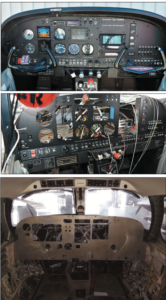
A common thread in the survey was downtime—lots of it. Unless it’s a minor upgrade (maybe installing a single radio or transponder), don’t expect it to be done quickly.
“Install time is measured in months, not weeks,” said Frank Humbles of the $55,000 Garmin retrofit for his piston single. His airplane was down for six months. But some installs simply go off the rails, as was the case with a Twin Bonanza and an owner who tried to do everything right.
“I scheduled my avionics installation eight months ahead of time and had the shop inspect it for an accurate quote. I was quoted two months, but budgeted three just to be safe. I delivered the plane on time and visited to check progress and answer questions every three to six weeks. The avionics installation still took over six months with a $7000 overrun on the Garmin TXi display installation. This put it out of annual, and I had to have that done by an unfamiliar shop on the field (insurance declined to cover a ferry flight to my usual shop) that tried to call ‘unairworthy’ on too much stuff,” said Craig Ketting of his project. In the end he’s happy with his choice of Garmin gear.
In some cases, you might bring the airplane back to the shop because equipment might not be available. Because of the COVID-19 pandemic, we’re hearing of parts shortages. FAA certifications are slowing, too.
“The installation was done in stages over an 18-month period because the S-TEC 3100 autopilot was not available at the time of the panel upgrade,” said John Brett of the project for his single. He reported excellent quality from Smart Avionics in Pennsylvania (and is very happy with his Aspen displays), although it took longer than expected because of the ADS-B rush.
Bernie Bartko, who had a new suite of Garmin avionics installed in his Cessna, had advice for knowing where you stand in the food chain.
“Many of the avionics shop hands are apprentices learning on your nickel, with several working on your upgrade and only one floor manager overseeing it. My advice before commencement is to get in writing firm completion timelines and clearly understand whether you are a priority customer or a fill-in customer,” he told us.
LEARNING IT
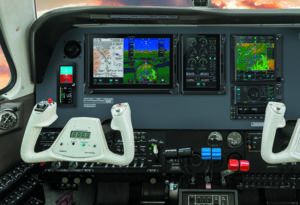
Understanding that there is a sizable learning curve that tags along with major avionics upgrades, we asked how it went. Nearly 53 percent said learning the new gear was very easy, 39 percent said it was somewhat challenging, 4.2 percent said it was difficult or very difficult and the rest were neutral. Remember, the majority of these users are operating Garmin equipment.
“I could not find anyone in my area for about six months who could instruct me on how to use the new setup. There were no Garmin or Sporty’s webinars yet on the GFC 500 autopilot and G5 EFIS I had installed,” said one respondent.
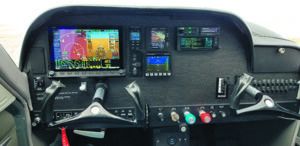
“The Avidyne IFD540 is complex, but fairly intuitive to operate. To me, it is more intuitive than the Garmin 750/650 series equipment. My biggest challenge was that I was going from two KX155 radios, round gauges and no GPS to a full-fledged navigation suite with GPS, traffic and weather—a lot to learn. Programming the 540 is actually pretty easy, once you understand the process. There are also plenty of YouTube videos and Avidyne tutorials to illustrate procedures,” John McNamee said of the new Avidyne gear in his airplane. After eight weeks of downtime, he flew away with a $35,000 invoice and felt as though Avidyne offers a competitive choice over Garmin.
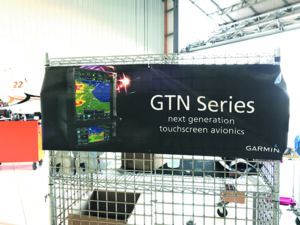
“Garmin training was fantastic. Its online course and YouTube training videos should be a bigger selling point than they are, and Garmin doesn’t put as much emphasis on this as they could. Videos by other trainers helped, too. The pilot guides and the flight manual supplement were useful, but last in line to the rest,” said one respondent. That’s good, because you might have to embrace the fact that you’ll be training yourself.
“No orientation was offered from the avionics shop. Pay the bill and fly away. In real time you need to recall or learn how to find things in menus and submenus. There has to be a better way. The best equipment I own are the ones that are intuitive and straightforward,” said another of the Garmin equipment in his airplane. We get it; but shops aren’t in the training business, their main focus is to get the airplane out the door with everything working and the customer satisfied. Still, you might choose a shop based partly on its ability to hook you up with an instructor who might get you comfortable with the equipment. Many shops have staff members who do just that. Others are concerned with liability.
The pandemic has pretty much killed the ability to try out the feature set of new equipment at trade shows and airshows, so now more than ever shops need to step up and help with the buying decision. This means having demo equipment on hand so you can see what works best with your skills. If they don’t, ask if they have a customer who would be willing to show off the equipment in their aircraft. In our experience, most owners are happy to help, so it’s worth the chase.
And if you don’t know which brand of equipment you even want, good shops will thoroughly explain your options, based on STC applicability, panel space and third-party compatibility. Bad shops try to only push brands for which they get sales incentives. PS Engineering audio panels come to mind, and we don’t know why more shops don’t suggest the brand even when installing a full suite of Garmin or Avidyne. Take the bull by the horns and ask if there are any other options you should consider if a shop favors one brand of avionics over another.
IS IT COMPATIBLE?
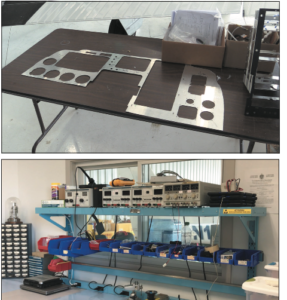
Of course, you may be forced into one brand over another because of compatibility issues. Third-party interfacing has been a tricky issue for a long time and while the industry has made some progress, don’t expect the new equipment to fully work with some of the existing gear that might be in your panel.
In the survey, only 52 percent said they were very satisfied with the functionality of the brand’s integration with other equipment, known as cross-brand compatibility. We heard from more than one Avidyne owner who is pleased with the brand’s ability to play nicely with others.
“The Avidyne IFD540 works very we’ll with my Aspen Pro PFD. The 540 connects seamlessly to the app on my iPad and I particularly like the small, handheld keyboard that comes with the 540. It makes programming the unit in turbulence much easier than a touch screen or spinning knobs. I also installed a JPI 830 engine monitor that connects to the 540 to display fuel data and calculated range. It alerts you to low fuel remaining if the flight plan extends beyond current fuel quantity—very handy,” said one.
“Getting the Garmin G5 EFIS and GTN 650 GPS to work with the existing S-TEC 30 autopilot has been challenging,” said another.
From our experience, learning that some aspects of the interface don’t work after you fly the aircraft away is perhaps the most dissatisfying part of a retrofit. Avoid that buzzkill and ask the shop if the new stuff will be completely compatible with any existing or even new equipment. Additionally, don’t assume that the equipment will be interfaced to its fullest potential. As an example, synthetic vision may be a desired feature of a new flight display, but you often have to pay for a software unlock for it to work. Ask a lot of questions beforehand and know exactly what you’ll be getting for the price that’s quoted.
RELIABILITY, COST VALUE
Good news on the reliability front—over 80 percent said their new gear has been very reliable, 12 percent had some reliability issues and only 2 percent said the equipment has been somewhat or very unreliable. Some issues may be related to installation problems, especially EFIS and autopilot problems.
“The remote magnetometer lags and sometimes the heading goes invalid during maneuvers,” said one of the EFIS in his airplane. The same owner wasn’t thrilled with the cost value of FAA-certified equipment, either, rating it very poor. “I am very disheartened at the final installation cost. I understand that avionics techs have to make a living, and certainly so do the manufacturers, but the cost compared to perfectly identical non-certified equipment is way too steep in 2020,“ he commented.
“A Garmin G5 and GTX 345 took 10 days to install and the cost was too (expletive) expensive!” said Bruce Young of his upgrade.
We asked about the warranty performance of the new equipment and 68 percent of the respondents reported no repairs—again vouching for the reliability of new equipment. Of those who did have issues, 23 percent said they were very satisfied with how it was handled under warranty and 6 percent were dissatisfied. For manufacturer support, overall, 46 percent said it was very good, 31 percent said it was satisfactory and 20 percent were neutral.
For certain, avionics installations are expensive—even with the cost of some equipment finally coming down. But, downtime is up. “My installation was estimated at four weeks. Soon after starting the project, Garmin experienced major issues with deliveries and the installation ended up being 12 weeks. I would not hesitate to recommend Garmin,” said Rex Booth of his install.
“Garmin needs to improve its data update system. There are typically many update failures at the face of the avionics, even though the datacard properly downloaded the data from Garmin. I did experience two failures of two units, one on warranty, but the other required $400 to repair even though Garmin knew of a defect,” said one respondent.
“Our airplane was down for seven months, and the cost was a little over $20,000 for just the installation labor. Cost for the Avidyne IFD 540, two Aspen E5’s, a Trio autopilot and angle of attack system totaled $32,000,” said Dennis Wolcott of the install in his airplane. Still, he said he would very likely buy the same equipment again.
As for improving their mission capability, the majority of respondents who commented on it said the investment did just that, while also offering a perceived increase in safety. In the end, we suppose that makes it worth it if you can swallow the big investment, long downtime and steep learning curve.
We’ll cover data costs in a dedicated article. If there’s something else you want to know about the results of our avionics upgrade polling that we didn’t mention here, drop us a line. We’ll keep the discussion going.




